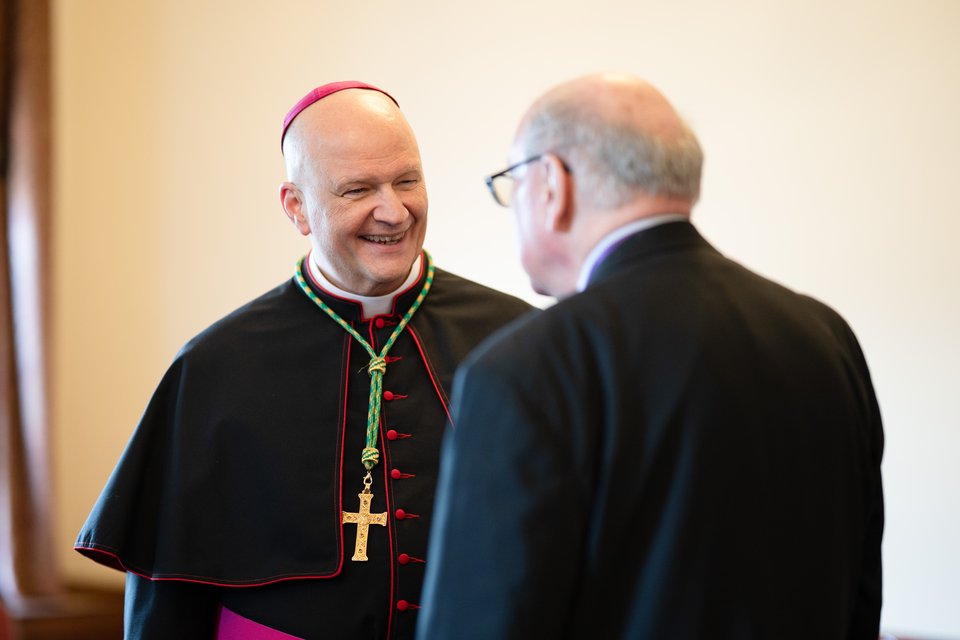DETROIT — Bishop Monforton's coat of arms — a tradition in the Catholic Church dating back centuries — tells a profound story of his family's history, the bishop's own personal history, his devotion to the saints and his deep love of the Lord.
Bishop Monforton chose his episcopal motto and coat of arms when he became bishop of the Diocese of Steubenville, Ohio, in 2012. Bishop Monforton's original coat of arms included elements from the Steubenville diocese; upon his return to his native Archdiocese of Detroit, the coat of arms has been slightly modified.
Below is a description of Bishop Monforton's coat of arms and episcopal motto, "Faith Comes from Hearing."
The Bishop’s personal coat of arms consists of three fields, or base colors: at the top (chief point) light blue; at the middle (or honor point) a bar (fess) of white; and at the bottom (base point) a field of red.
The chief point of the shield depicts the, Mivtzar Monfor, a ruined crusader castle in the upper Galilee region of northern Israel. The name of the fortress derives from two French words — mont (a mountain) and fort (strong), meaning "strong mountain." Built by the French at the beginning of the last millennium, the castle name comes from the same derivation as the Brittany family name of Bishop Monforton. Bishop Monforton’s family on his father’s side traces their heritage to the Brittany area of northwestern France. His ancestors emigrated from there to Canada almost 400 years ago.
Although Montfort Castle in Galilee saw some military use during the Middle Ages when it passed into Teutonic and later Baibar hands, it was primarily noted for its agricultural significance. In Jesus’ time, Galilee was the site of many of his miracles and agricultural parables. It remains a most fertile and productive area of the Holy Land.
The center, or honor point, of Bishop Monforton’s Coat of Arms contains three red roses. They pay tribute to St. Therese of Lisieux, the patroness of the National Shrine of the Little Flower in Royal Oak, Michigan — where Bishop Monforton had his first priestly assignment — and the patroness of Bishop Monforton’s first pastorate, St. Therese of Lisieux Parish, in Shelby Township, Michigan. In her autobiography, St. Therese wrote, "My mission — to make God loved — will begin after my death. I will spend my heaven doing good on earth. I will let fall a shower of roses." Roses have been described and experienced as Saint Therese's signature.
The bottom part, or base point, of Bishop Monforton’s Coat of Arms features a rampant lion. “Rampant” signifies that the animal is rearing up on one hind foot and fighting with its front paws. The rampant lion is found on the Coat of Arms of the English branch of the Monforton family. But in the application used for Bishop Monforton, the rampant lion is not fighting; instead he holds a crowned, wounded heart in its front paws. This is the coat of arms of Sacred Heart Major Seminary in Detroit, Michigan, where Bishop Monforton was the rector and president for six years.
Covering the top of the shield and used in Episcopal heraldry since the Tenth Century, is the “Gallero.” It is also known as a “pilgrim’s hat” because of its wide brim protecting the traveler from the elements. In this context, the Gallero indicates a bishop’s willingness to journey to distant places for the faith — while at the same time expecting the protection of the shadow of God as noted in Psalm 84:12: “For a sun and shield is the Lord God, bestowing all grace and glory. The Lord withholds no good thing from those who walk without reproach” (NAB). During Bishop Monforton’s tenure as Rector, Sacred Heart Major Seminary conducted annual seminarian pilgrimages to the Holy Land.
The Gallero has a cord attached to it. It is flanked by two sets of six tassels, or “fiocchi.” Originally this cord and tassels were a simple of way of securing the hat to the traveler’s head. Tradition now dictates that a bishop’s Gallero and cord are depicted in the color green, with six tassels arranged in three rows on either side, indicating the rank of bishop.
Above and behind Bishop Monforton's shield, there appears a processional cross which further reinforces the theme of “bishop and his people as pilgrims” — persons on the move for the sake of the Lord’s kingdom. The cruciform used here is that of the Jerusalem Cross. It consists of a central cross signifying the city of Jerusalem from which the faith spread, surrounded by four minor crosses. It was part of the coat of arms of the short-lived Jerusalem Kingdom (1099-1203 AD). Scholars posit that the central cross represents the strength of Christianity. The four smaller crosses represent the spread of Christianity to the four corners of the earth. The Jerusalem Cross is used today by the Equestrian Order of the Holy Sepulchre of Jerusalem, a fraternal, charitable organization charged by the Vatican with the task of providing for the needs of the Latin Patriarchate of Jerusalem, and for all the activities and initiatives which are necessary to support the Christian presence in the Holy Land. Bishop Monforton was inducted into the Equestrian Order of the Holy Sepulchre in 2011, and thus merits the use of the Jerusalem Cross.
Motto: 'Faith Comes from Hearing'
It is customary for a new bishop to select a written motto to complete his Coat of Arms. This serves as a motif for his ministry. This motto is placed on a ribbon or scroll at the base of the processional cross. Bishop Monforton has selected for his motto a passage from St. Paul’s Letter to the Romans: “Faith Comes From Hearing.” The full passage from Romans 10:17 reads: “… faith comes from hearing, and that means hearing the word of Christ” [New Jerusalem Bible]. Bishop Monforton selected this evangelical motto because he sees that the mission of the Church in his time will be increasingly marked by a new hearing of God's word and a new evangelization — bringing to the ears of the world our Catholic, communal faith experience, and proclaiming our faith in new cultural contexts.
Prepared and executed for the Most Reverend Jeffrey Monforton in August of 2008 by the Rev. Timothy Pelc of the Archdiocese of Detroit, with the assistance of Stephanie Ruttinger and Christine Busque. Text taken from the Diocese of Steubenville's website.
Copy Permalink
Bishops











